Content
Published:
This is an archived release.
Leaking water pipeline system
In 2014, around one out of three litres, or around 32 per cent of the 750 million cubic metres of drinking water supplied by the municipal waterworks was “lost” through leakage. This corresponds to 5.5 cubic metres of water per metre of pipeline system in that particular year.
| 2010 | 2013 | 2014 | Change in per cent | ||
|---|---|---|---|---|---|
| 2010 - 2014 | 2013 - 2014 | ||||
| Per cent of population connected to municipal water supply | 83.5 | 84.6 | 83.8 | 0.4 | -0.9 |
| Average household consumption per person per day (litre) | 213 | 208 | 206 | -3.3 | -1.0 |
| Per cent of total water pipeline system renewed, 3-year-average | 0.63 | 0.64 | 0.64 | 1.6 | 0.0 |
| Percentage of population supplied with hygienically safe drinking water with regard to E. Coli | 95.8 | 99.5 | 99.3 | 3.7 | -0.2 |
| Operating expenditures per inhabitant connected to municipal wastewater facilit | 790 | 885 | 923 | 16.8 | 4.3 |
| Fee calculation basis per inhabitant connected to muncipal distribution | 1 157 | 1 265 | 1 305 | 12.8 | 3.2 |
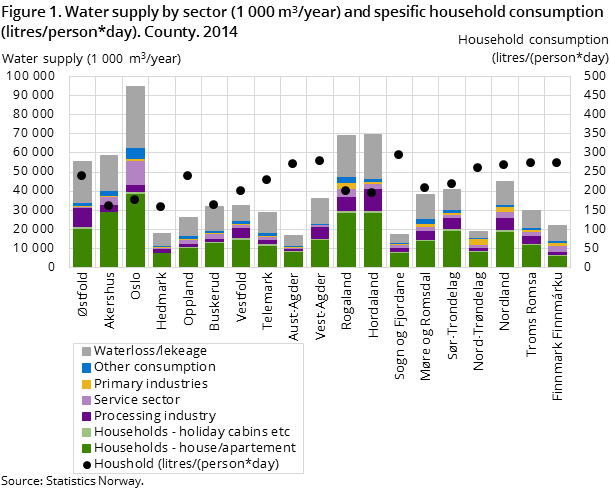
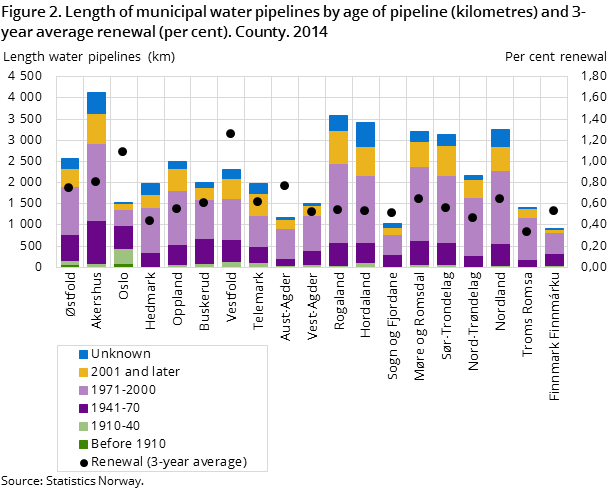
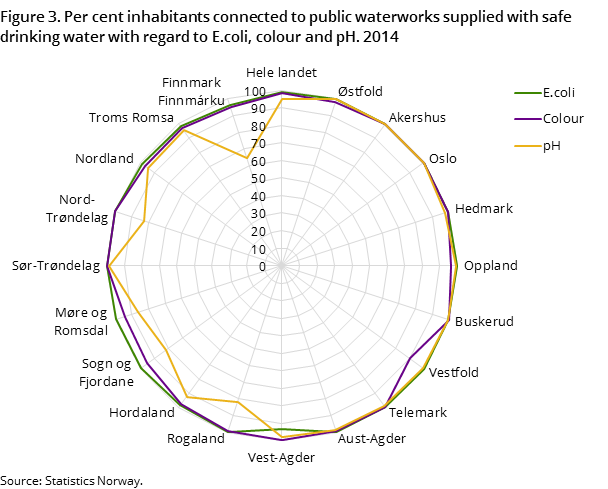
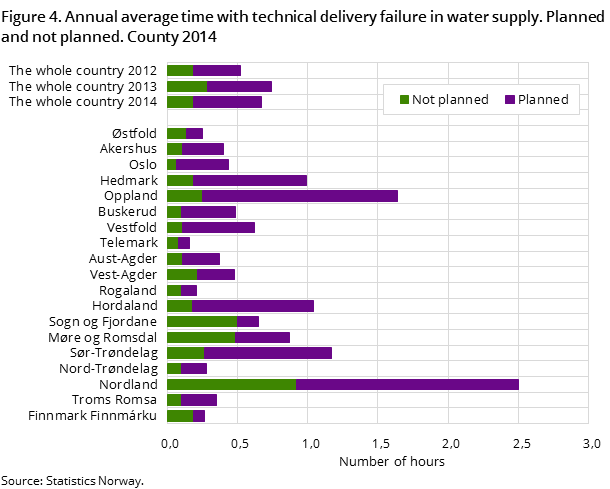
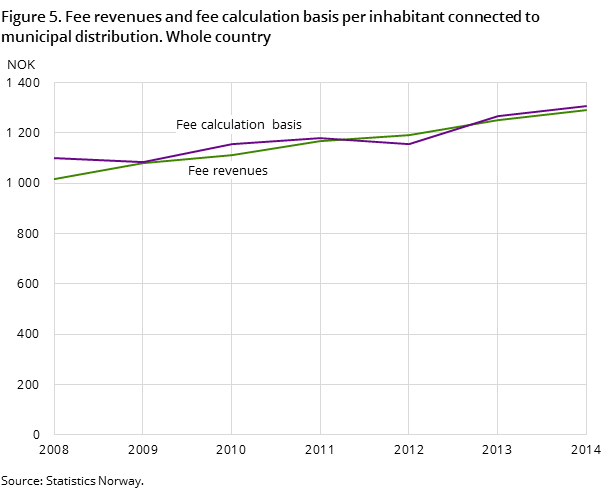
According to KOSTRA figures (system for municipality-to-state-reporting), the loss through leakage has been relatively stable throughout the last ten years.
In comparison, around 42 per cent of water supplied by municipal waterworks to the pipeline system is consumed by households. An additional 2 per cent is consumed in holiday cottages or holiday homes. This gives a specific water consumption in the households of around 206 litres a day per person.
Satisfactory water quality
Around 4.3 million inhabitants in Norway were connected to the 1 100 municipal waterworks located around the country (not including those serving only schools and kindergartens). This corresponds to a share of 84 per cent of Norway’s population. Dispersed across the water distributing system, this implies an average of 100 persons per kilometre of pipeline. When also including private waterworks, the total is around 4.5 million people and 2 000 waterworks.
In 2014, a total of 99, 98 and 95 per cent of inhabitants respectively were connected to municipal waterworks that provided water with an acceptable content of thermo-tolerant intestinal bacteria (E. coli), colour and levels of acidity (pH).
Safety and readiness plans against “unwanted incidents”
Less than 90 per cent of the municipal waterworks had a safety and readiness plan against unwanted incidents e.g. pollution hazards, failure in hygienic barriers and other technical failures, drought/flood, accidents. Furthermore, around 30 per cent of the municipal waterworks carried out safety and readiness training in 2014.
0.6 per cent of pipelines renewed
The renewal rate of municipal water pipelines varies from one year to another. Calculated as a 3-year moving average for the period 2012-2014, the rate of renewal is 0.6 per cent of the total pipeline system. This is around the same level as the year before.
The current renewal rate means that it will take almost 160 years to renew the whole pipeline system, assuming that no new pipelines are installed in the coming years.
Half the pipeline system from between 1971 and 2000
The length of the municipal water pipelines is estimated to be nearly 43 800 kilometres; the same as the earth’s circumference at the equator. About half of the municipal pipeline system was laid between 1971 and 2000, around 3 per cent was laid before 1940 and 18 per cent between 2001 and 2014. The age and quality of the pipeline systems vary considerably between municipalities.
The age of the pipeline system for the country as a whole is estimated at 33 years.
Drinking water under “pressure”
Booster pumps are used in many areas of Norway to transport drinking water to consumers. There are around 2 400 such pumps around the country, which corresponds to an average of 1 booster pump every 20 kilometres of water pipeline. If the pressure was to drop, there is a risk that polluted water from the outside may come into contact with the drinking water inside the pipelines. Thus, it is important to reduce pressure drops to a minimum by renewing old pipelines and ensuring effective routines are in place for planned stops in the water supply.
40 minutes of delivery failure
The estimated average annual technical delivery failure in the municipal water supply in 2014 was around 40 minutes per person. Twenty-five per cent of this, or around 10 minutes, is related to unplanned incidents by the waterworks.
Furthermore, around 3 800 leakage repairs were also estimated to have been carried out on the water pipeline system in 2014, corresponding to 1 leak repair per 10 kilometres of pipeline. This is around the same level as in 2013.
Income from fees and fee calculation basis almost equal
In 2014, the fee calculation basis per inhabitant was NOK 1 305, which constitutes an increase of 3 per cent compared to 2013. Income from fees was NOK 1 290 in 2014; an increase of 3 per cent since 2013.
Municipal costs in the water sector are predominantly covered by fees paid by the users of the service. Regulations stipulate that fees in the municipal water and wastewater sector cannot exceed the municipality’s actual costs for providing that particular service (“self cost”). Accurately stipulating income from fees to cover the real calculation basis in a single year is complicated. Thus, the municipalities are allowed to decide on fee levels so that income from fees over a five-year period equals the fee calculation basis.
The income from fees was 1 per cent lower than the fee calculation basis in 2014; the same trend as for the 5-year time period 2010-14.
Contact
-
Gisle Berge
E-mail: gisle.berge@ssb.no
tel.: (+47) 48 12 19 97
